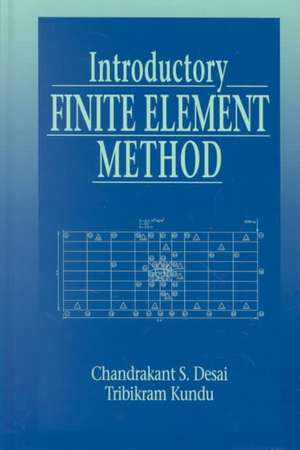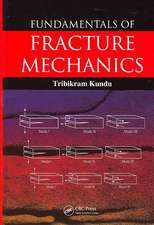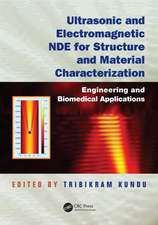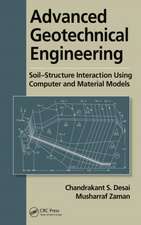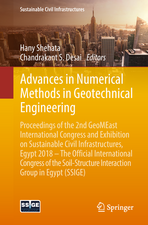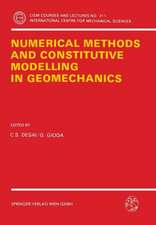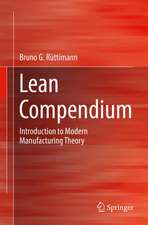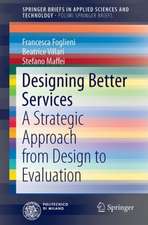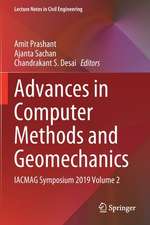Introductory Finite Element Method: Mechanical and Aerospace Engineering Series
Autor Chandrakant S. Desai, Tribikram Kunduen Limba Engleză Hardback – 18 mai 2001
Introductory Finite Element Method examines both structural analysis and flow (heat and fluid) applications in a presentation specifically designed for upper-level undergraduate and beginning graduate students, both within and outside of the engineering disciplines. It includes a chapter on variational calculus, clearly presented to show how the functionals for structural analysis and flow problems are formulated. The authors provide both one- and two-dimensional finite element codes and a wide range of examples and exercises. The exercises include some simpler ones to solve by hand calculation-this allows readers to understand the theory and assimilate the details of the steps in formulating computer implementations of the method.
Anyone interested in learning to solve boundary value problems numerically deserves a straightforward and practical introduction to the powerful FEM. Its clear, simplified presentation and attention to both flow and structural problems make Introductory Finite Element Method the ideal gateway to using the FEM in a variety of applications.
Din seria Mechanical and Aerospace Engineering Series
- 9%
 Preț: 1147.84 lei
Preț: 1147.84 lei - 9%
 Preț: 1281.04 lei
Preț: 1281.04 lei - 18%
 Preț: 1806.82 lei
Preț: 1806.82 lei - 27%
 Preț: 1235.67 lei
Preț: 1235.67 lei - 26%
 Preț: 1045.42 lei
Preț: 1045.42 lei - 15%
 Preț: 591.84 lei
Preț: 591.84 lei - 15%
 Preț: 461.03 lei
Preț: 461.03 lei - 28%
 Preț: 1021.92 lei
Preț: 1021.92 lei - 29%
 Preț: 1099.44 lei
Preț: 1099.44 lei - 11%
 Preț: 319.68 lei
Preț: 319.68 lei - 28%
 Preț: 1321.65 lei
Preț: 1321.65 lei - 29%
 Preț: 1059.23 lei
Preț: 1059.23 lei - 25%
 Preț: 857.50 lei
Preț: 857.50 lei - 15%
 Preț: 489.26 lei
Preț: 489.26 lei - 22%
 Preț: 352.95 lei
Preț: 352.95 lei -
 Preț: 516.42 lei
Preț: 516.42 lei -
 Preț: 275.87 lei
Preț: 275.87 lei - 15%
 Preț: 328.37 lei
Preț: 328.37 lei - 18%
 Preț: 867.06 lei
Preț: 867.06 lei - 18%
 Preț: 1238.86 lei
Preț: 1238.86 lei - 18%
 Preț: 896.13 lei
Preț: 896.13 lei - 18%
 Preț: 1012.58 lei
Preț: 1012.58 lei - 18%
 Preț: 1800.14 lei
Preț: 1800.14 lei - 15%
 Preț: 582.18 lei
Preț: 582.18 lei - 18%
 Preț: 794.27 lei
Preț: 794.27 lei - 18%
 Preț: 1252.78 lei
Preț: 1252.78 lei - 18%
 Preț: 850.50 lei
Preț: 850.50 lei - 18%
 Preț: 1398.05 lei
Preț: 1398.05 lei - 18%
 Preț: 1138.99 lei
Preț: 1138.99 lei - 23%
 Preț: 721.54 lei
Preț: 721.54 lei - 28%
 Preț: 1263.49 lei
Preț: 1263.49 lei - 30%
 Preț: 2147.18 lei
Preț: 2147.18 lei - 29%
 Preț: 1997.82 lei
Preț: 1997.82 lei
Preț: 1015.76 lei
Preț vechi: 1238.73 lei
-18% Nou
Puncte Express: 1524
Preț estimativ în valută:
194.39€ • 202.20$ • 160.48£
194.39€ • 202.20$ • 160.48£
Carte tipărită la comandă
Livrare economică 12-26 aprilie
Preluare comenzi: 021 569.72.76
Specificații
ISBN-13: 9780849302435
ISBN-10: 0849302439
Pagini: 518
Ilustrații: 1229 equations; 2 Halftones, black and white; 15 Tables, black and white; 200 Illustrations, black and white
Dimensiuni: 156 x 234 x 32 mm
Greutate: 0.9 kg
Ediția:1
Editura: CRC Press
Colecția CRC Press
Seria Mechanical and Aerospace Engineering Series
ISBN-10: 0849302439
Pagini: 518
Ilustrații: 1229 equations; 2 Halftones, black and white; 15 Tables, black and white; 200 Illustrations, black and white
Dimensiuni: 156 x 234 x 32 mm
Greutate: 0.9 kg
Ediția:1
Editura: CRC Press
Colecția CRC Press
Seria Mechanical and Aerospace Engineering Series
Public țintă
UndergraduateCuprins
Preface. Introduction. Steps in the Finite Element Method. One-Dimensional Stress Deformation. One-Dimensional Flow. One-Dimensional Time-Dependent Flow. Combined Computer Code for One-Dimensional Deformations, Flow, and Temperature/ Consolidation. Beam Bending and Beam Column. One-Dimensional Mass Transport. One-Dimensional Stress Wave Propagation. Two- and Three-Dimensional Formulations. Torsion, Potential, Thermal, Electrical, and Fluid Flow. Two-Dimensional Stress-Deformation Analysis. Multicomponent Systems: Building Frame and Foundation. Appendices.
Recenzii
"This is an excellent addition to the available textbooks on finite element method…The mathematical formulations and fundamental concepts illustrated with simple examples and summaries or comments and plenty of exercises presented at the end of each chapter are other merits of the book…The book is highly recommended for undergraduate students and teachers in universities."
- Appl Mech Rev, Vol. 55, no. 1
"Intended for use… within and outside engineering disciplines, this book examines both stress-deformation analysis and flow (heat and fluid) applications…. offers an introduction to the finite element method…"
-Sci Tech Book News, Vol. 25, No. 3, September 2001
- Appl Mech Rev, Vol. 55, no. 1
"Intended for use… within and outside engineering disciplines, this book examines both stress-deformation analysis and flow (heat and fluid) applications…. offers an introduction to the finite element method…"
-Sci Tech Book News, Vol. 25, No. 3, September 2001
Notă biografică
Desai, Chandrakant S.; Kundu, Tribikram
Descriere
Introductory Finite Element Method examines both structural analysis and flow applications in a presentation designed for upper-level undergraduate and beginning graduate students, both within and outside of the engineering disciplines. It includes a chapter on variational calculus, clearly presented to show how the functionals for structural analysis and flow problems are formulated. The authors provide both one- and two-dimensional finite element codes and a wide range of examples and exercises. The exercises include some simpler ones to solve by hand calculation, alllowing readers to understand the theory and the details of formulating computer implementations.
